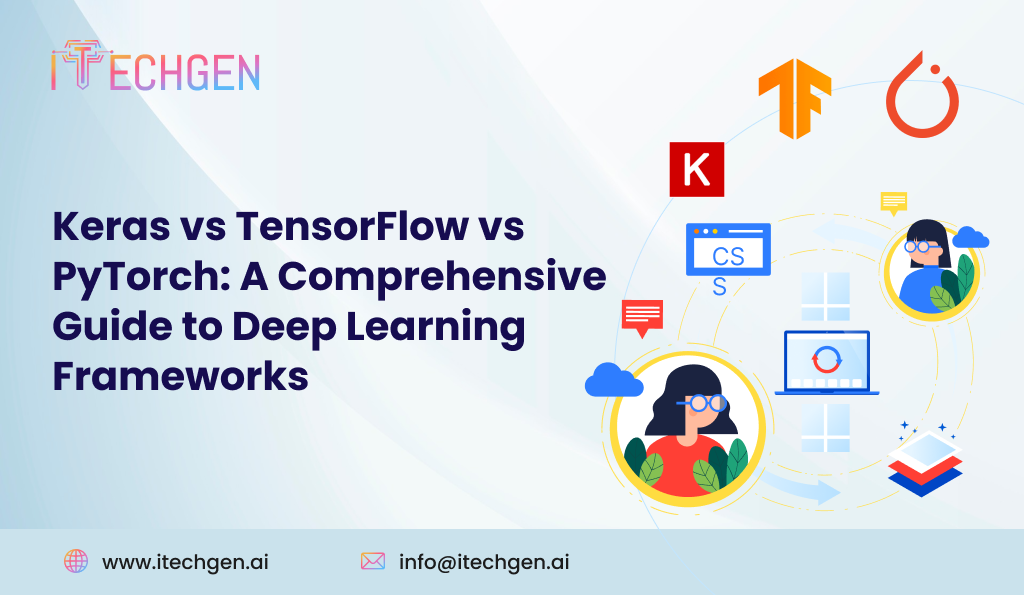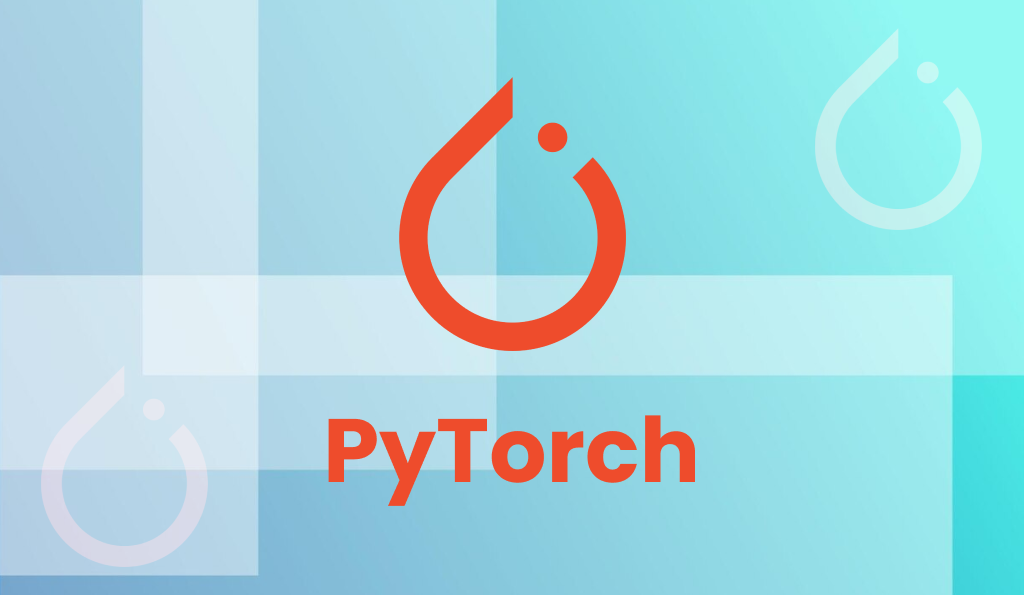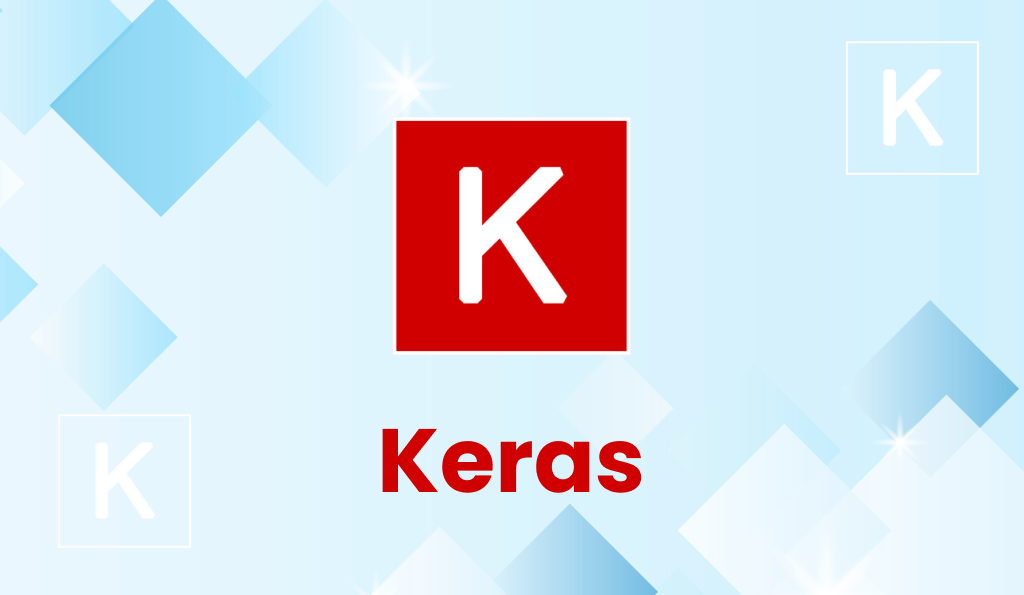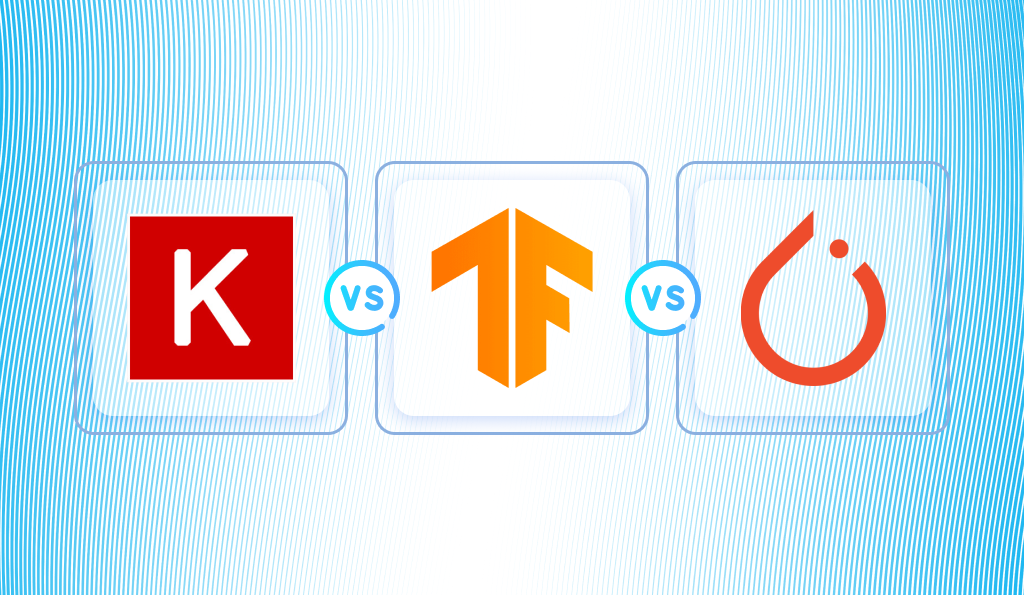
During the last decade, deep learning has become one of the most transformative technologies and applied to natural language processing, computer vision, and predictive analytics. The major frameworks behind this revolution include Keras, TensorFlow, and PyTorch, democratizing AI and allowing you to build and deploy neural networks without much effort. But picking the right framework is not one size fits all.
Each framework comes with a set of capabilities, strengths, and trade-offs. Therefore, you need to be careful before you choose the one that fits your demands the most. So, whether you’re an academic researcher a startup, or an enterprise developer, no matter which tool you choose, it can greatly affect the scalability, performance, and success of your project. In this guide, we examine these frameworks in depth, comparing their features, applications, and ecosystems, to equip you with the knowledge you need to make the choice that serves your AI objectives best.
The framework you choose can determine the efficiency of your development process, the scalability of your model, and even the ethical implications of its deployment. According to Gartner’s AI Adoption Report, over 80% of AI leaders attribute their project’s success to choosing tools that align well with their operational needs and scalability goals. Conversely, 25% of projects fail because the frameworks do not fit their use cases.
For instance, PyTorch’s dynamic computation graphs are ideal for iterative experimentation, making it popular in academic research. On the other hand, TensorFlow’s robust production-ready capabilities cater well to enterprise needs where deployment at scale is critical. Keras simplifies the model-building process, which can significantly accelerate prototyping for startups. Making the right choice requires a nuanced understanding of both the project requirements and the framework’s features, as this alignment determines not only performance but also cost efficiency and time to market.
Deep learning is a type of artificial intelligence that uses multi-layered neural networks to analyze complex data. These networks imitate how the human brain learns, powering applications once seen as science fiction. Unlike traditional machine learning, which often relies on feature engineering, deep learning autonomously extracts meaningful features from raw data, making it ideal for handling unstructured datasets such as images, videos, and natural language.
The importance of deep learning extends beyond technological innovation—it is reshaping industries. For example, healthcare is leveraging deep learning for diagnostics, agriculture for yield predictions, and entertainment for creating personalized user experiences. A recent study published in Nature Communications revealed that deep learning models have surpassed human experts in specific diagnostic tasks, underlining their transformative potential.
The machine learning market is expected to grow from $21.17 billion in 2022 to $209.91 billion by 2029, with a CAGR of 38.8%.

The versatile deep learning is essential in many fields:
These real-world applications underscore the need to understand and select the right framework, as different use cases demand different capabilities.

Facebook AI Research (FAIR) developed PyTorch, a favorite among researchers for its flexibility, and dynamic computation graphs. Its ability to modify and iterate on models at runtime is invaluable for experimental projects. Besides that, PyTorch has a busy ecosystem of libraries and extensions like PyTorch Lightning, which take care of severe model training.
The active community around PyTorch is another strength, contributing tutorials, plugins, and pre-trained models that reduce development time. Its extensive use in academia has also led to numerous cutting-edge innovations being implemented first in PyTorch before being adapted for other frameworks. The fastest growing framework among researchers is cited in 60% of the papers presented at the top AI conferences.
Nearly 61 percent of papers at the top AI conferences cited PyTorch as the preferred framework, according to research, which suggests that PyTorch has a bright future ahead of it in research and academia. This is due to its ease of use and dynamic computation graph, which simplifies experimentation.

TensorFlow, developed by Google Brain, is known for its reliability in production and extensive tools. Unlike PyTorch, it uses static computation graphs, which boosts performance for large-scale use. Tools like TensorBoard for visualizations and TensorFlow Lite for edge devices, make it ideal for enterprise applications.
TensorFlow’s scalability handles massive datasets and complex models effortlessly, and integration with Google Cloud supports highly scalable AI deployments. TensorFlow has also incorporated ethical AI features, like fairness indicators, which are essential for responsible AI development.
TensorFlow remains the leader in industry applications, being used by companies for large-scale deployments, thanks to its mature ecosystem and tools like TensorFlow Extended and TensorFlow Serving.

Keras, built on TensorFlow, simplifies deep learning with a user-friendly, modular design, making it easy to build, train, and deploy models with minimal code. Despite its simplicity, Keras does not compromise on power, offering features like automatic hyperparameter tuning and integration with TensorFlow’s extensive ecosystem.
Keras’s flexibility extends to its deployment options, supporting models on mobile devices, web applications, and even Java Virtual Machines. This versatility makes Keras an excellent choice for startups and small teams looking to rapidly prototype and deploy AI solutions.

| Aspect | Keras | TensorFlow | PyTorch |
| Primary Use | Rapid prototyping | Production-ready, large-scale models | Research, experimentation |
| Graph Type | Static (via TensorFlow) | Static computation graphs | Dynamic computation graphs |
| Ease of Use | Very user-friendly, high-level API | Steeper learning curve | Pythonic, flexible syntax |
| Flexibility | Less flexible, abstracts many details | High flexibility for fine-tuning | Highly flexible, great for research |
| Deployment | Relies on TensorFlow’s backend | Excellent production deployment options | Growing deployment tools |
| Scalability | Limited scalability | High scalability and distributed training | Improved scalability with PyTorch Lightning |
| Performance | Moderate performance | Optimized for large-scale performance | Great for research, less for production |
| Popular Use Cases | Prototyping, small-to-medium models | Large-scale industrial applications | Research and academic projects |
PyTorch’s dynamic computation graphs allow for greater flexibility in model experimentation, making it ideal for research projects. TensorFlow’s static graphs, on the other hand, offer optimized execution, crucial for large-scale applications. Keras abstracts much of this complexity, providing a simpler interface for developers who want to focus on innovation rather than technical intricacies.
PyTorch’s Pythonic syntax makes it intuitive, particularly for those familiar with Python programming. TensorFlow has a steeper learning curve but compensates with extensive documentation and a wealth of tutorials. Keras is by far the most beginner-friendly, allowing developers to build functional models with minimal effort, making it a favorite among newcomers to deep learning.
For enterprise applications requiring scalability, TensorFlow leads the pack. Its distributed training capabilities and Google Cloud integration make it suitable for handling vast amounts of data. PyTorch, boosted by PyTorch Lightning, improves scalability, while Keras leverages TensorFlow’s backend for comparable performance.
While TensorFlow excels in large-scale deployments, PyTorch often outperforms in experimental setups due to its flexibility. Keras, optimized for prototyping, offers decent performance but may not match the raw efficiency of TensorFlow or PyTorch in production environments. Benchmarks vary by use case, making it essential to consider specific requirements when evaluating performance.
The ecosystems surrounding these frameworks add significant value. PyTorch Lightning simplifies complex workflows, TensorFlow.js enables AI applications in browsers, and Keras Tuner automates hyperparameter tuning. These tools enhance functionality, ensuring that each framework can cater to diverse development needs.
TensorFlow’s integration with Google Cloud AI provides unmatched scalability and deployment options. PyTorch is supported by AWS SageMaker, offering robust solutions for cloud-based machine learning. Keras benefits from TensorFlow’s ecosystem, ensuring seamless deployment on various platforms.
1. Autonomous Vehicles
Developing autonomous vehicles like Tesla’s Autopilot involves using PyTorch. It takes in real-time data from sensors, cameras, and radar in order to make quick decisions like changing lanes, detecting obstacles, etc. Its dynamic computation graph helps Tesla rapidly improve and adapt models, enhancing safety and efficiency in autonomous driving. Its ability to work with large sensor datasets and provide fast updates is vital for real-time systems like these.
2. Healthcare
TensorFlow is commonly used in healthcare for predictive models and medical imaging. It analyzes data from critical care units, such as heart rate and blood pressure, to predict patient outcomes and enable early intervention. Research, like a study in the Journal of Medical Research, shows TensorFlow can improve survival rates by up to 20%. Its scalability and tools like TensorFlow Lite, make it ideal for healthcare applications, such as wearable devices and large hospital systems.
3. Retail
Keras is used in retail to create personalized shopping experiences. Keras-driven recommendation systems are used by e-commerce platforms to recommend products based on past behavior, thus increasing customer retention and sales. An example is Forrester Research showing that personalized recommendations increase retention by up to 30%. Keras’ easy interface promotes quick prototyping which makes it the best option for retail companies looking to improve customer experience as well as revenue.
The landscape of AI is changing due to emerging trends like federated learning and edge AI. Federated Learning from TensorFlow is a library to address data privacy and train models on decentralized devices.
PyTorch is advancing edge AI with its support for on-device machine learning, crucial for IoT applications.
TensorFlow is focusing on AutoML to make AI accessible to non-experts, while PyTorch is enhancing ethical AI tools. Keras is expanding its support for new hardware accelerators, ensuring its relevance in future AI developments.
Each framework—Keras, TensorFlow, and PyTorch—has distinct strengths tailored to specific use cases, making them invaluable in deep learning.
PyTorch is ideal for research and experimentation, offering flexibility with dynamic computation graphs and a Pythonic design, making it a favorite in academia and innovative projects.
TensorFlow is ideal for enterprise applications, providing robust production tools, scalability, and smooth cloud integration. Its vast ecosystem supports large-scale AI deployments.
Keras built on TensorFlow, simplifies rapid prototyping with a user-friendly interface, making it great for startups and developers focused on quick development.
We, at iTechGen, have made it easy for you by using the restaurant industry as an example to explain in simple terms, when to choose each option based on your needs:
When to Choose What?
TensorFlow: If you’re working for a restaurant chain (big projects) and need the tools to scale and automate complex workflows.
PyTorch: If you’re a chef exploring new recipes (researchers and developers building new models).
Keras: If you’re cooking at home for yourself (small models or just starting in AI).
Deep learning and enterprise AI continue to drive the growth of the global AI market at over 40% CAGR by 2028. Which framework to use depends on your project needs and will make for a scalable and effective solution.
The primary difference lies in their architecture and intended use cases:
For deep learning research, PyTorch is favored because it is flexible, its graphs are dynamic, and it’s easy to use. This allows researchers to quickly experiment with variations of model architectures, or try out new theories.
Keras is great for rapid prototyping and can be used in production, especially with TensorFlow, as its backend. TensorFlow offers the scalability and performance needed for enterprise deployment, while Keras model-building process.

Pankaj Arora is the Founder & CEO of iTechGen, a visionary leader with a deep passion for AI and technology. With extensive industry experience, he shares expert insights through his blogs, helping businesses harness the power of AI to drive innovation and success. Committed to delivering customer-first solutions, Pankaj emphasizes quality and real-world impact in all his endeavors. When not leading iTechGen, he explores emerging technologies and inspires others with his thought leadership. Follow his blogs for actionable strategies to accelerate your digital transformation and business growth.
View More About Pankaj Arora